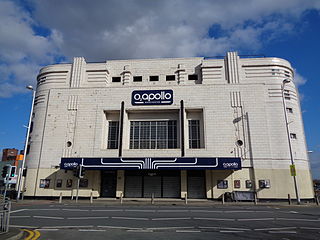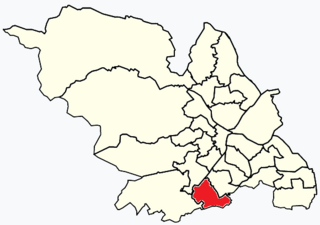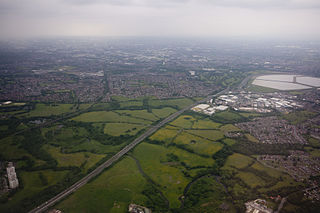
Landover is an unincorporated community and census-designated place in Prince George's County, Maryland, United States. Landover is located very close to Washington, although it does not directly border Washington D.C. unlike its neighboring communities, Chapel Oaks and Fairmount Heights, which directly border Washington D.C. and go all the way up to/touch the Maryland/ D.C. line. As of the 2010 census it had a population of 23,078.

Wilmslow Road is a major road in Manchester, England, running from Parrs Wood northwards to Rusholme. There it becomes Oxford Road and the name changes again to Oxford Street when it crosses the River Medlock and reaches the city centre.

Owens Park is a large hall of residence located in the Fallowfield district of the city of Manchester, England. The hall is owned by the University of Manchester and houses 1,056 students. Owens Park is a significant part of the Fallowfield Campus of the University of Manchester. The terms 'Owens Park' and 'Fallowfield Campus' are sometimes used interchangeably.

Hulme is an inner city area and electoral ward of Manchester, England, immediately south of Manchester city centre. It has a significant industrial heritage.

Wythenshawe is an area of south Manchester, England.

Gorton is an area of Manchester in North West England, southeast of the city centre. The population at the 2011 census was 36,055. Neighbouring areas include Audenshaw, Denton, Levenshulme, Openshaw, and Reddish.

Ardwick is a district of Manchester in North West England, one mile south east of the city centre. The population of the Ardwick Ward at the 2011 census was 19,250.

The O2 Apollo Manchester (known locally as The Apollo and formerly Manchester Apollo) is a concert venue in Ardwick Green, Manchester, England. It is a Grade II listed building, with a capacity of 3,500 (2,514 standing, 986 seats).

Beauchief and Greenhill ward—which includes the districts of Batemoor, Beauchief, Chancet Wood, Greenhill, Jordanthorpe, and Lowedges—is one of the 28 electoral wards in City of Sheffield, England. It is located in the southern part of the city and covers an area of 2.4 square miles (6.2 km2). The population of this ward in 2016 was estimated to be 19,669 people in 9,209 houses.
Thomas Brown was an English surveyor, civil engineer, businessman and landowner.

Piccadilly Gardens is a green space in Manchester city centre, England, between Market Street and the edge of the Northern Quarter. Piccadilly runs eastwards from the junction of Market Street with Mosley Street to the junction of London Road with Ducie Street; to the south are the gardens and paved areas. The area was reconfigured in 2002 with a water feature and concrete pavilion by Japanese architect Tadao Ando.
Allerton railway station was a railway station on the City Line of the Merseyrail network, located in the suburbs of Liverpool, England.

Reddish Vale is in the Tame Valley close to Reddish, Greater Manchester, England. The centre of the vale is around the bottom of Reddish Vale Road. Reddish Vale Country Park is a country park managed by Stockport Metropolitan Borough Council. It covers 161 hectares in all and comprises some of the traditional Reddish Vale area, Reddish Vale Farm and the grazing land and Woodhall Fields, about half a mile to the south. Part of it is a designated local nature reserve.

Potternewton is a suburb and parish between Chapeltown and Chapel Allerton in north-east Leeds, West Yorkshire, England. It is in the Chapel Allerton ward of Leeds City Council.
Ardwick Hall was a large country house set amongst grounds and conservatories on the eastern side of Ardwick Green in Manchester.
Allerton Tower Park is a public park in Allerton, Liverpool, in England.

Hyde Road Stadium often referred to as Belle Vue was the home of the Belle Vue Aces speedway team. The stadium's` capacity was 40,000 and it was built in 1928 and used until demolished in 1987. It was claimed, incorrectly, to have been the first purpose built speedway track in Britain.

Cheetham Hill Road is a road in north Manchester, England, running from Corporation Street in Manchester city centre to Prestwich. In Crumpsall 53°30′44″N2°14′38″W, its name changes to Bury Old Road. It is lined with churches, mosques, synagogues and temples, as well as terraced houses.

Ancoats Hall in Ancoats, Manchester, England, was a post-medieval country house built in 1609 by Oswald Mosley, a member of the family who were Lords of the Manor of Manchester. The old timber-framed hall, built in the early 17th century, was described by John Aiken in his 1795 book Description of the country from 30 to 40 miles around Manchester. The old hall was demolished in the 1820s and replaced by a brick building in the early neo-Gothic style. The new hall, at the eastern end of Great Ancoats Street between Every Street and Palmerston Street, was demolished in the 1960s.















